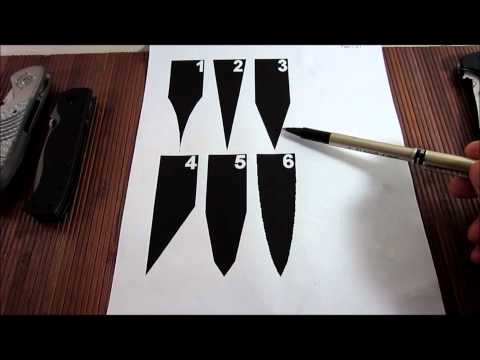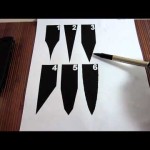
ce403b648fb0fddd4f4ca9dac01fa6c1
Knives are essential tools for everyday life, and the type of grind on the blade can make a big difference in how well it performs. In this article, we will explore the different types of knife grinds and how they affect the performance of the blade. We will also discuss the advantages and disadvantages of each type of grind, so you can make an informed decision when choosing the right knife for your needs.
What are the different grinds on knife blades
Knives come in all shapes and sizes, and the grind of the blade is an important factor in determining the knife’s performance. A grind is the shape of the blade’s cross-section, and it affects the knife’s sharpness, strength, and durability. There are several different grinds, each with its own advantages and disadvantages.
Flat Grind
The flat grind is the most common grind used on knives. It is created by grinding both sides of the blade in a straight line from the spine to the edge. This grind is easy to sharpen and provides a good balance between strength and sharpness. It is a good choice for general-purpose knives.
Hollow Grind
The hollow grind is created by grinding the blade in a concave shape from the spine to the edge. This grind is very sharp, but it is also very weak and prone to chipping. It is best used for specialized tasks such as skinning and butchering.
Chisel Grind
The chisel grind is created by grinding one side of the blade in a straight line from the spine to the edge, while the other side is left unground. This grind is very sharp, but it is also very weak and prone to chipping. It is best used for specialized tasks such as woodworking.
Convex Grind
The convex grind is created by grinding the blade in a convex shape from the spine to the edge. This grind is very strong and durable, but it is also difficult to sharpen. It is best used for heavy-duty tasks such as chopping and splitting.
Scandinavian Grind
The Scandinavian grind is created by grinding the blade in a convex shape from the spine to the edge, with a secondary bevel on the edge. This grind is very sharp and strong, and it is easy to sharpen. It is a good choice for general-purpose knives.
Conclusion
The grind of a knife blade is an important factor in determining its performance. There are several different grinds, each with its own advantages and disadvantages. It is important to choose the right grind for the task at hand in order to get the best performance from your knife.
What is the most versatile knife grind
Knife grinds are the various shapes and angles that are ground into the blade of a knife. Different grinds are used for different purposes, and the most versatile grind is the one that can be used for a variety of tasks. The most versatile knife grind is the full flat grind, which is a single bevel that runs from the spine of the blade to the edge. This grind is great for slicing, chopping, and piercing, and it is also easy to sharpen.
The hollow grind is another popular grind that is often used for hunting and skinning knives. This grind is created by grinding the blade in a concave shape, which creates a very sharp edge. The hollow grind is great for slicing and skinning, but it is not as durable as the full flat grind.
The convex grind is a grind that is created by grinding the blade in a convex shape.
This grind is great for chopping and slicing, and it is also very durable. The convex grind is not as sharp as the hollow grind, but it is still a great choice for a versatile knife.
The scandi grind is a grind that is created by grinding the blade in a flat shape with a slight curve. This grind is great for slicing and chopping, and it is also very easy to sharpen. The scandi grind is not as durable as the full flat grind, but it is still a great choice for a versatile knife.
No matter what type of knife you are looking for, there is a grind that will suit your needs. The full flat grind is the most versatile grind, but the hollow grind, convex grind, and scandi grind are all great choices for a versatile knife. Each grind has its own advantages and disadvantages, so it is important to choose the one that best suits your needs.
What is the difference between V grind and Scandi grind
When it comes to sharpening knives, there are two main types of grinds: V grind and Scandi grind. Both of these grinds have their own unique advantages and disadvantages, and it is important to understand the differences between them in order to choose the right one for your needs.
V Grind is a type of grind that is created by grinding the blade of a knife in a V-shaped pattern. This type of grind is often used for knives that are used for slicing and cutting, as it provides a very sharp edge that is easy to maintain. The downside to this type of grind is that it can be difficult to sharpen, as the V-shaped pattern can be difficult to replicate.
Scandi Grind is a type of grind that is created by grinding the blade of a knife in a flat pattern. This type of grind is often used for knives that are used for chopping and slicing, as it provides a very sharp edge that is easy to maintain. The downside to this type of grind is that it can be difficult to sharpen, as the flat pattern can be difficult to replicate.
In conclusion, the main difference between V grind and Scandi grind is the shape of the blade. V grind is a V-shaped pattern, while Scandi grind is a flat pattern. Both of these grinds have their own advantages and disadvantages, and it is important to understand the differences between them in order to choose the right one for your needs.
What is the difference between a hollow grind and a sabre grind
Knife grinds are the shape of the blade that is created when the blade is ground down from its original shape. There are many different types of grinds, each with its own unique characteristics and advantages. Two of the most popular grinds are the hollow grind and the sabre grind.
Hollow grind is a type of grind that is created by removing material from both sides of the blade, creating a concave shape. This type of grind is popular for its ability to create a very sharp edge, as well as its ability to be easily sharpened. However, it is not as strong as other grinds, and can be prone to chipping.
Sabre grind is a type of grind that is created by removing material from one side of the blade, creating a convex shape. This type of grind is popular for its strength and durability, as well as its ability to hold an edge for a long time. However, it is not as sharp as other grinds, and can be difficult to sharpen.
In conclusion, the hollow grind and the sabre grind are two of the most popular grinds for knives. The hollow grind is popular for its ability to create a very sharp edge, while the sabre grind is popular for its strength and durability. Each type of grind has its own advantages and disadvantages, so it is important to choose the one that best suits your needs.
We hope this guide has been helpful in understanding the different types of knife grinds and blade profiles. We wish you the best of luck in finding the perfect knife for your needs. Goodbye and take care!














